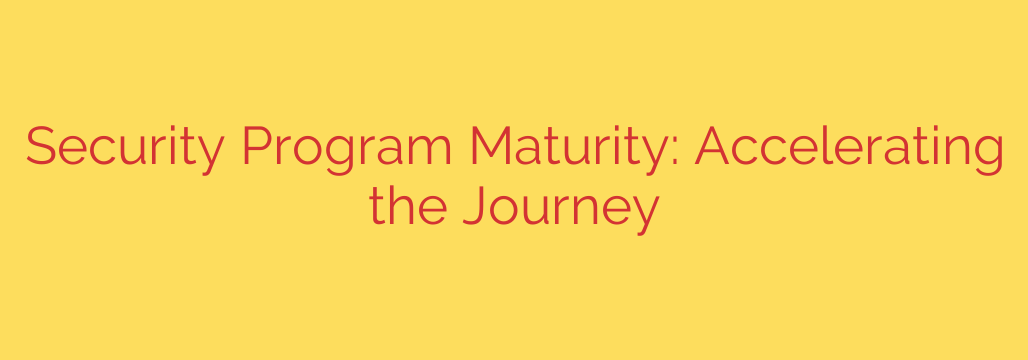
Beyond the Basics: A Guide to Accelerating Your Security Program Maturity
In today’s complex threat landscape, many organizations find themselves in a constant state of reactive “firefighting.” They lurch from one security alert to the next, struggling to keep up with an overwhelming volume of threats and vulnerabilities. This approach is not only exhausting but also fundamentally ineffective. The key to breaking this cycle is to shift focus from merely managing incidents to building a mature, resilient, and proactive security program.
But what does a “mature” security program actually look like, and how can you get there faster? This guide provides a clear roadmap for accelerating that journey, transforming your security function from a reactive cost center into a strategic business enabler.
What is Security Program Maturity?
Security program maturity is the measure of how formalized, proactive, and effective an organization’s cybersecurity processes and capabilities are. It’s about moving beyond simply having security tools in place. A mature program integrates people, processes, and technology into a cohesive system that anticipates threats, manages risk intelligently, and continuously improves.
Think of it in stages:
- Initial/Reactive: Security is chaotic and unpredictable. The focus is entirely on putting out fires.
- Developing/Repeatable: Basic processes are established, but success often depends on individual heroics.
- Defined/Proactive: Formal processes are documented and followed across the organization. The focus shifts to prevention.
- Managed/Measured: The organization uses metrics to measure the effectiveness of its security controls and make data-driven decisions.
- Optimized/Resilient: The program is in a state of continuous improvement, using predictive analytics and threat intelligence to adapt to new threats before they materialize.
The goal is to move up this ladder as efficiently as possible.
Common Roadblocks on the Path to Maturity
Many security programs stall for predictable reasons. Recognizing these hurdles is the first step to overcoming them.
- Tool Overload and Complexity: A sprawling collection of disconnected security tools creates more noise than clarity, overwhelming analysts and hindering a unified view of risk.
- Lack of a Guiding Framework: Without a strategic framework, security efforts are often disjointed and misaligned with business objectives.
- Compliance-Driven Security: Chasing compliance checkboxes can lead to a false sense of security while failing to address the unique risks your organization actually faces.
- Data Silos: When vulnerability data, threat intelligence, and asset information live in separate systems, it’s impossible to get a complete picture and prioritize effectively.
5 Key Strategies to Accelerate Your Security Journey
To move past these roadblocks, you need a deliberate and strategic approach. Here are five essential strategies to accelerate your program’s maturity.
1. Adopt and Operationalize a Security Framework
Instead of reinventing the wheel, anchor your program to an established, industry-recognized framework. Frameworks like the NIST Cybersecurity Framework (CSF), ISO 27001, or the CIS Controls provide a structured blueprint for building a comprehensive security program. The key is not just to adopt a framework but to operationalize it—mapping its controls directly to your tools, processes, and risk management activities. This provides a clear path forward and a common language for discussing security across the business.
2. Shift to Risk-Based Prioritization
Not all vulnerabilities are created equal. A mature program understands that a “critical” vulnerability on a non-essential internal server is less of a priority than a “medium” vulnerability on a public-facing, mission-critical application. Stop chasing every single alert and start prioritizing based on actual business risk. This requires combining three crucial data points:
* Vulnerability Severity: The technical score of the weakness (e.g., CVSS).
* Threat Intelligence: Is this vulnerability being actively exploited in the wild, particularly against your industry?
* Asset Criticality: How important is the affected system to your business operations?
Focusing your limited resources on the threats that pose the greatest danger is the fastest way to reduce real-world risk.
3. Integrate and Automate Your Security Stack
Your security tools should work together, not in isolation. A unified security platform is fundamental to accelerating maturity. By integrating your vulnerability scanner, asset inventory, threat intelligence feeds, and ticketing systems, you can automate critical workflows. This integration allows you to automatically correlate threat data with vulnerabilities on critical assets and trigger remediation workflows, freeing up your security team to focus on strategic initiatives rather than manual data correlation.
4. Leverage Actionable Threat Intelligence
Generic threat intelligence is just noise. To be effective, your intelligence must be tailored and actionable. A mature program leverages threat intelligence that is specific to its own technology stack, industry, and geographic location. This allows security teams to proactively hunt for threats that are most likely to target them and to prioritize patches for vulnerabilities that are known to be exploited by active threat actors.
5. Measure What Matters and Communicate Value
You cannot improve what you cannot measure. A mature security program is data-driven. Develop key performance indicators (KPIs) that track not just activity, but outcomes.
Instead of reporting “we patched 10,000 vulnerabilities,” report on metrics like:
- Mean Time to Remediate (MTTR): How quickly are you fixing critical vulnerabilities?
- Reduction in Attack Surface: Are you demonstrably shrinking the number of exposed, vulnerable systems?
- Risk Score Reduction: Is the overall risk posture of your critical business applications improving over time?
Presenting these business-aligned metrics to leadership is crucial for demonstrating the value of the security program and securing the ongoing investment needed for continuous improvement.
By embracing these strategies, you can systematically advance your security program’s maturity, moving from a reactive and overwhelmed state to a proactive, resilient, and risk-aware posture that truly protects and enables the business.
Source: https://www.helpnetsecurity.com/2025/08/12/what-makes-a-security-program-mature-video/








